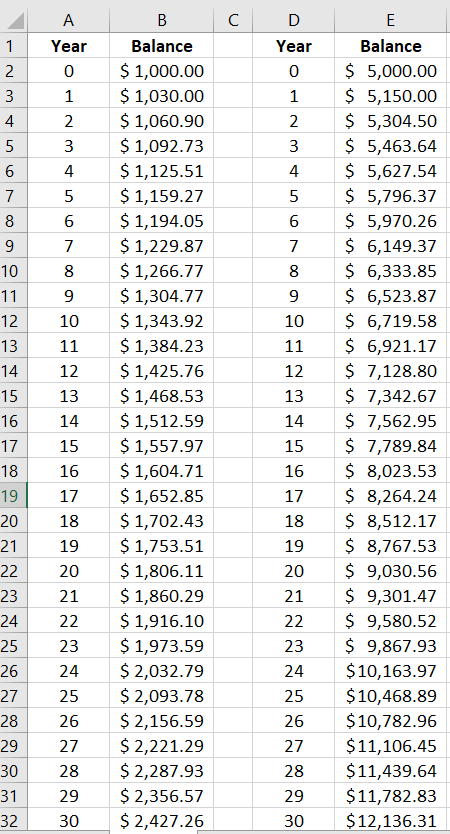Section 2.1 Introduction to Spreadsheets
Objectives: Section 2.1 Introduction to Spreadsheets
Students will be able to:
Perform basic calculations on a spreadsheet
Use cell references and the fill-down feature
A spreadsheet such as Google Sheets or Microsoft Excel, is a very useful tool for doing calculations and making complex tables. You can type in your own custom calculations or use the built-in formulas.
The rectangles within a spreadsheet are called cells, and they can be referenced by their column letter and row number. The first cell in the upper left side highlighted below is A1. If we wanted to talk about the third column and the fifth row, that cell would be C5.
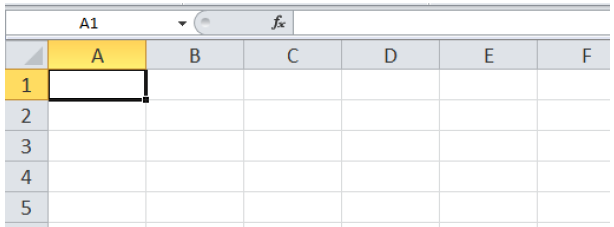
A spreadsheet file can contain many sheets. Look along the bottom to see if there is more than one sheet and make sure you are on the right sheet.

Subsection 2.1.1 Basic Calculations
To do a calculation on a spreadsheet, type an equal sign before the operation. This lets the program know that you want it to calculate the result. When you press enter, you will see the result.
Example 2.1.1.
To add 3 + 4, enter
=3+4To subtract 100-76, enter
=100-76To multiply 4 times 18, enter
=4*18To divide 0.05 by 12, enter
=0.05/12To calculate \(5^{25}\text{,}\) enter
=5^25
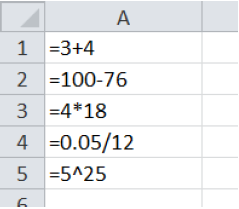
Note that the asterisk (*) is used for multiplication. Spreadsheets don’t recognize parentheses as indicators of multiplication like calculators do, so even if you have parentheses for the order of operations, the asterisk is also needed.
You can make more complicated mathematical expressions using parentheses and other operations. To edit a cell click on the editing box at the top, or double click on the cell to edit it directly.
Example 2.1.2.
Your bill at a restaurant is $35.75 and you want to leave an 18% tip. How much would you add to the bill?
To work with a percentage, we need to convert it into a decimal first, and then multiply it by the base amount.
In a spreadsheet we would type
=0.18*35.75
and get a result of $6.44, rounded to the nearest cent. You would leave a tip of $6.44.
Subsection 2.1.2 Cell References
One of the powerful things about spreadsheets is using a cell reference, such as C5 in a calculation. When you use a cell reference, the values will automatically update if any of the referenced values change.
Let’s make a spreadsheet for the percentage tip example above. We calculated an 18% tip on a bill of $35.75. We might want to tip 18% in general, but our bill will change values. We labeled the first column Bill Amount and the second column Tip. The amount of $35.75 is entered in cell A2. Then when we write our formula in B2, we want to calculate 18% of A2. That way if the number in A2 changes, our tip will automatically update.
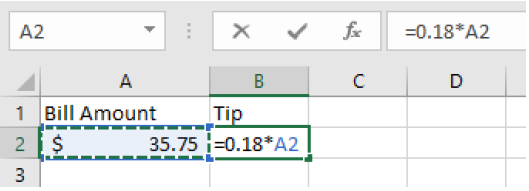
The formula
=0.18*A2
is entered in B2 which gives a result of $6.44 when you hit enter.
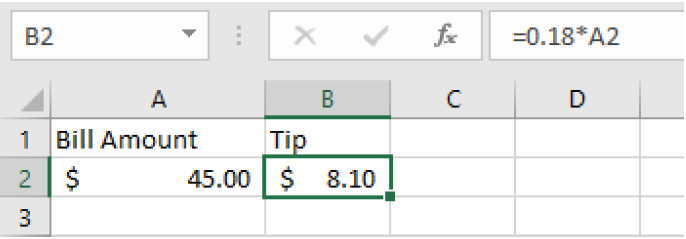
When the bill amount is changed, the tip is recalculated.
Subsection 2.1.3 Cell Formatting
We can also format cells A1 and B1 to show dollar signs by clicking on the dollar sign in the number formatting menu.
Subsection 2.1.4 Fill-Down Feature
The fill-down feature is very useful for making tables. This allows us to copy values or formulas to save time. Let’s make a tipping reference table with values from $10, to$100, in increments of $10. First, we will enter two values in column A to establish the pattern. Then select those two cells and you will see a small square in the lower right corner. Drag that square down until you get to $100.
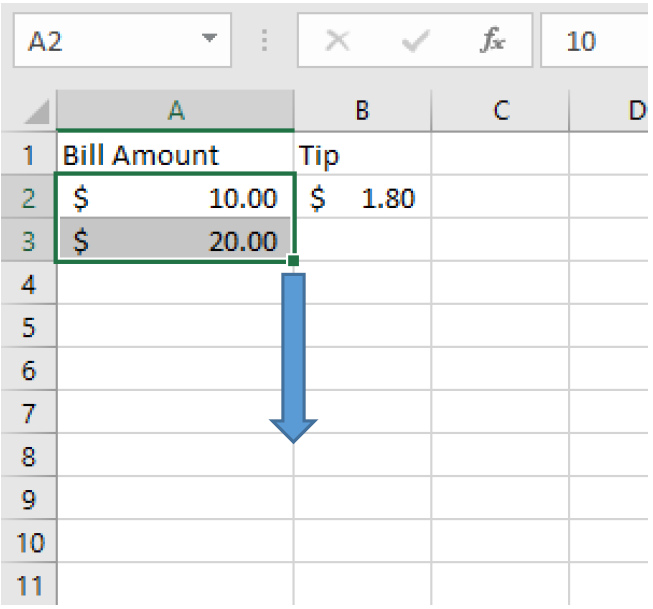
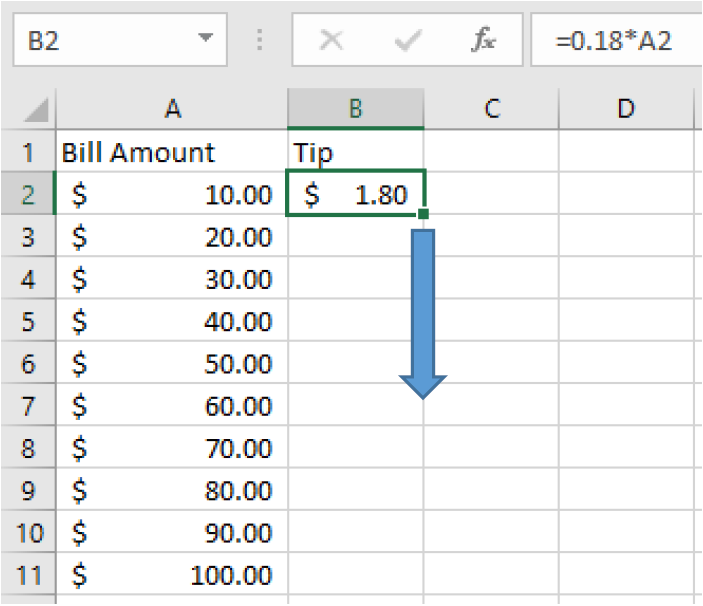
Next, we can drag our formula down and the cell reference will change to each row number automatically.
Here are the formulas with the row numbers updated:
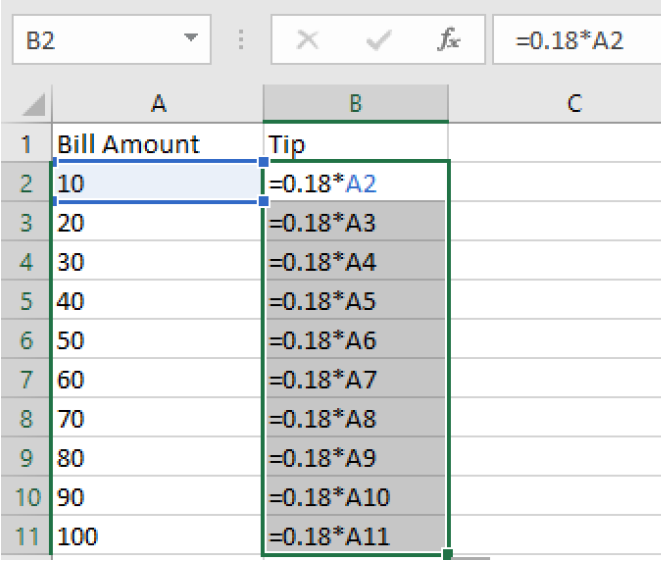
Here is our completed table with the calculations:
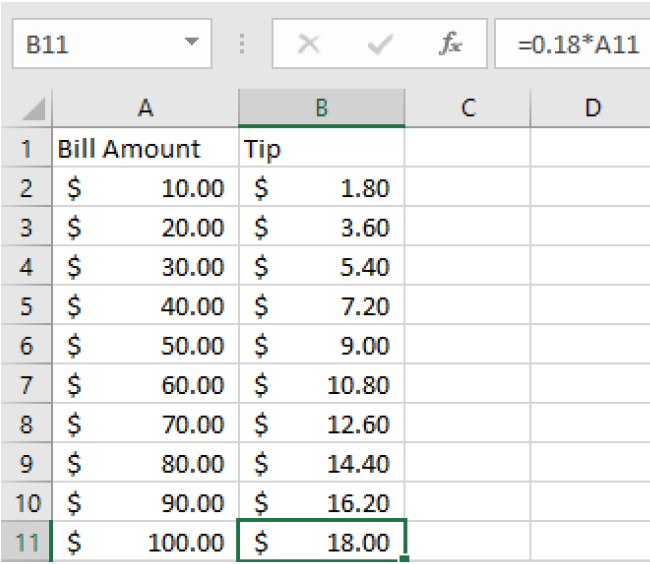
Subsection 2.1.5 Formulas
Spreadsheets have many useful built-in formulas. We will introduce some of the financial formulas in this chapter. Here are some of the formulas we will use:
=FVto calculate the future values of an investment=PVto calculate the deposit needed for a desired future balance=PMTto calculate a loan or savings plan payment=EFFECTto calculate the effective rate of an account and compare accounts
In the rest of this chapter we will use spreadsheets and formulas to calculate the future values, interest paid or earned and monthly payments.
Exercises 2.1.6 Exercises
Use a spreadsheet to compute the following.
1.
Convert \(4/7\) to a decimal
=4/7 which gives approximately 0.571429
2.
Convert 16% to a decimal
=16% which gives 0.16
3.
Add 8 and 19
=8+19 which gives 27
4.
Find the difference of 230 and 78
=230-78 which gives 152
5.
Multiply 12 and 9
=12*9 which gives 108
6.
Divide 0.09 by 52
=0.09/52 which gives approximately 0.001731
7.
Calculate \(8^3\)
=8^3 which gives 512
8.
Your bill at a restaurant is $55.75 and you want to leave a 20% tip. How much would you add to the bill?
=55.75*20% which gives 11.15 or eleven dollars and fifteen cents
9.
You leave a tip for $7.50 for a bill at a restaurant that is $44.50. What percent tip did you leave?
=7.50/44.50 which gives approximately 0.168539, or approximately 16.8539%
10.
In Column A use the fill down feature to build a spreadsheet starting with $5 and ending at $125, in increments of $5. In Column B write a formula with a cell reference to calculate a 15.5% tip on the amount in Column A. Use the fill down feature to complete your table.
See the table below:
Note, the entry in cell B1 is =15%*A1. (Columns A and B are given dollar formatting)

11.
Imagine a certain savings account started out with a balance of $5250.00 on day-one, and today has a current balance of $5780.23
Exactly how much more money does the account have today, compared with day-one?
Rounding to the nearest tenth of a percent: By what percentage amount has the account balance grown?
If instead, the bank balance today was exactly double the starting balance, then by what exact percentage amount would the bank balance have grown?
If the bank balance today had instead grown by 15.5% since day-one, then what would be the exact amount of today’s balance?
=5780.23-5250which gives 530.23 dollars=530.23/5250which gives approximately 0.100996, or approximately 10.1%Exactly 200%
=5250*115.5%which gives exactly 6063.75 dollars
12.
Imagine that at the start of a certain month, you will make an opening deposit of $500 into a savings account, and you will then leave the account alone (meaning you will make no further deposits or withdrawals). Also, for this account: Every month after the opening deposit, the amount in the account will grow to be 101% of its previous month’s balance.
Use a spreadsheet to enter 500 in cell A1. Using a formula and a cell-reference: Compute in cell A2, the amount in the account after one month has passed. Then using the fill down feature, continue the pattern for another eleven full months (you should end at cell A13). Format all the cells to show dollar signs. What is the amount in the account after one year?
Now continue the pattern in column A of your spreadsheet to extend for a second full year (you should end at cell A25). What is the amount in the account after two years?
What overall percentage growth occurred in the account between the opening deposit and one year later? (Compute using a formula and cell references)
What overall percentage growth occurred in the account between the end of year one, and the end of year two? (Compute using a formula and cell references)
(Challenge) The annual percentage growth that you found in part (d) for the second year, should be identical to the annual percentage growth that you found in part (c) for the first year. Can you mathematically explain why this is true? Do you think this pattern of identical overall annual percentage growth would continue, if you extend the pattern for even more years?
-
See the table at the bottom for part a and part b.
After 1 year, the account holds $563.41
-
See the table at the bottom for part a and part b.
After 2 years, the account holds $634.87
=A13/A1which gives \(\approx 112.6825\%\) growth=A25/A13which gives \(\approx 112.6825\%\) growth (same)Each starting value increases mathematically by a factor of \((1.01)^{12}\) each year, which is \(\approx 112.6825\%\text{.}\) So yes, this pattern must continue indefinitely into future years.

13.
Imagine that at the start of a certain year, you will deposit $1000.00 into a savings account, and then you will leave the account alone. Each year after the opening deposit, the amount in the account will grow to be 103% of its previous year’s balance.
After two years, the account balance will have experienced two growth amounts of 103%. You can find this account balance amount here, with the spreadsheet computation
= 1000 * (103%) * (103%). Perform this computation in a spreadsheet and write the balance that you find.Now enter the spreadsheet computation
= 1000 * (103%)^2. Notice that the result here, which involves using a power, gives the same answer as you found in part (a). Comparing the two spreadsheet computations: Explain why they give the same result.Using the pattern in part (b) above, and carefully choosing the power: Compute the balance that will be in the account fifteen full years after the account was originally opened. (Round to the nearest cent)
(Challenge) Make a spreadsheet that shows the account balance each individual year for 30 years. From the date of the opening deposit: What minimum number of full years will you have to wait, until the balance finally exceeds twice its opening deposit amount? (Use cell references, the fill down feature, and dollar formatting)
(Challenge) Imagine the opening balance of the account was $5000.00 instead of $1000.00 (and everything else about the account stays the same). Make a similar spreadsheet as you did in part (d), and using this spreadsheet, find the minimum number of full years you will have to wait this time, until the balance finally exceeds twice its opening deposit amount. How does this answer compare with your answer in part (d)? Do you think your answer would be the same here, for any positive opening balance you may choose for the account?
=1000*103%*103%which gives 1060.90 dollars.=1000*(103%)^2gives the same result of 1060.90 dollars, because raising 103% to the second power means the same as multiplying 103% by itself two times.=1000*(103%)^15which gives 1557.97 dollars (to the nearest cent).-
Refer to the table at the bottom for part d and part e.
Note the entry in cell B3 here is
= B2*103%and the remaining cells are computed using the fill down feature.You will have to wait a minimum of 24 full years, in each case, in order for the balance to finally exceed twice the opening deposit amount.
Since \((103\%)^{23} \lt 2 \lt (103\%)^{24}\text{,}\) the minimum number of full years until the opening deposit doubles must be the same here, for any positive opening balance that we may choose for this account.
